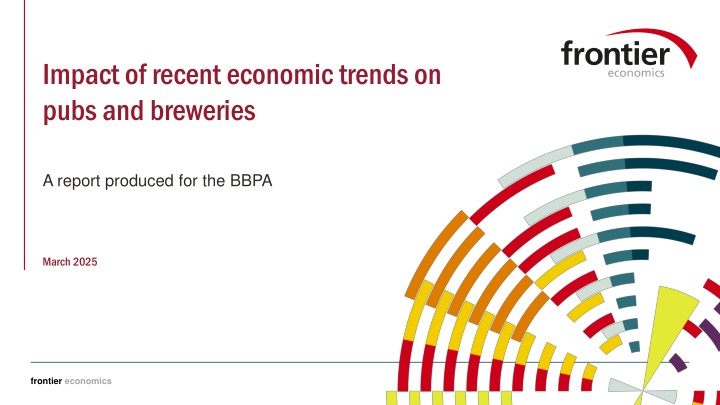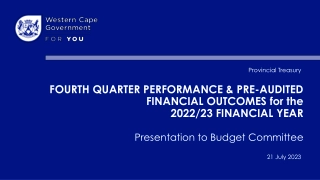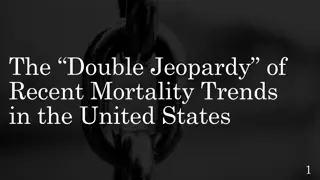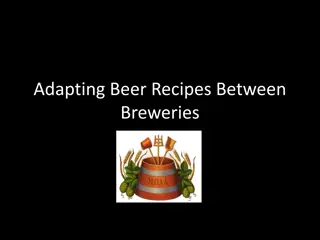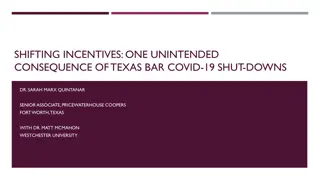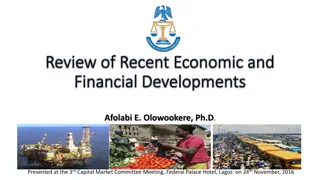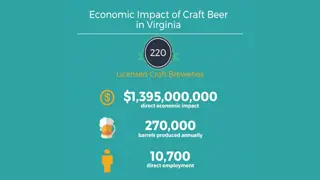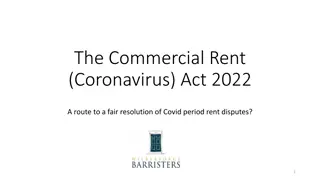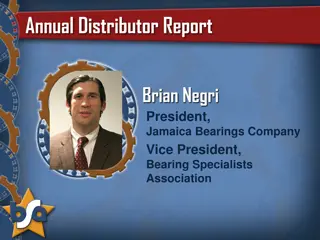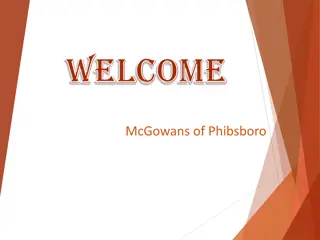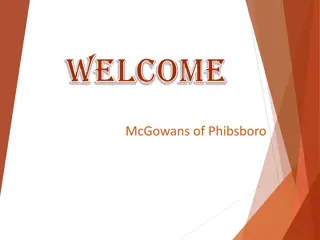Impact of Recent Economic Trends on Pubs & Breweries: Analysis Report 2025
This report by Frontier Economics, commissioned by the BBPA, delves into the economic landscape affecting pubs and breweries post-Covid. Explore the challenges faced, changing cost dynamics, policy impacts, investment constraints, consumer confidence, and sector adaptation strategies.
Download Presentation

Please find below an Image/Link to download the presentation.
The content on the website is provided AS IS for your information and personal use only. It may not be sold, licensed, or shared on other websites without obtaining consent from the author.If you encounter any issues during the download, it is possible that the publisher has removed the file from their server.
You are allowed to download the files provided on this website for personal or commercial use, subject to the condition that they are used lawfully. All files are the property of their respective owners.
The content on the website is provided AS IS for your information and personal use only. It may not be sold, licensed, or shared on other websites without obtaining consent from the author.
E N D
Presentation Transcript
Impact of recent economic trends on pubs and breweries A report produced for the BBPA March 2025 frontier economics
Contents Topic Summary Supporting detail: Economic environment facing pubs & brewers Annex 1: Landscape of pubs and brewers in the UK Annex 2: Economic model of pubs and brewers Annex 3: Current economic impact on pubs and brewers Annex 4: Methodology and interview findings frontier economics 2
About this report Frontier Economics were commissioned by The British Beer and Pub Association (BBPA) in Autumn 2022 to analyse the pub and brewery sector, the pressures faced post-Covid, and why the sector is particularly distinctive in the need for support. Given the rapidly changing economic environment and pressures faced by the sector, this report provides an update to the economic environment facing pubs and brewers as of early 2025. This report builds on the previous update from August 2023, focusing on how costs and demand have changed over the past year and what is expected to happen over the next year. This report does not re-examine the overall landscape and economic model of pubs and brewers which will not have changed. This part of the analysis has been moved to Annex 1 and 2. frontier economics 3
Acute shocks have eased but pressures remain, with further impact of rising labour costs, business rates, and new regulations and differential impacts across firms 01 02 03 Some economic pressures have eased but high costs remain structurally embedded While inflation has eased and some costs have started to fall, overall expenses such as energy, wages, and supply chain costs remain high vs historic levels (and many of these costs remain volatile). Further cost pressures incoming, driven by policy interventions Multiple policy changes will hit sector costs in 2025 NLW, NMW and NICs increases, EPR / PRN changes, reduction in Business Rates Relief, and changes to Business Property Relief. Businesses seek growth but investment is constrained Pubs and brewers continue to innovate and adapt, but further investment is needed to unlock long-term growth. While some businesses actively invest in expansion and innovation, uncertainty around costs, demand, and regulation holds others back. Businesses are having to navigate both the cumulative cost impact of these and the uncertainty of some (EPR in particular). Competitive, slim margin sector so higher costs have largely been passed through to customers via higher prices. Larger businesses better positioned to capitalise on opportunities, while smaller and mid-sized businesses are potentially more exposed to burden of new regulation and cost pressures. Any reductions in energy or raw materials are offset by these new pressures. Consumer confidence has slightly improved from record lows in 2023 but remains fragile, and spending is still cautious, despite slight improvements from recent lows. There is concern that further price hikes, particularly in pubs, will push customers away, impacting volumes and margins. Investment and operational decisions are made at the pub level so as well as independents, some managed community pubs despite part of larger groups remain exposed. frontier economics 4
Pubs and brewers face a range of demand and cost pressures over the next year In addition to structurally higher costs DEMAND AND COST PRESSURES OVER THE NEXT YEAR STRUCTURALLY HIGHER COSTS COMMODITIES COMMODITIES PACKAGING POLICIES PACKAGING POLICIES CONSUMER DEMAND CONSUMER DEMAND Coming down off peaks but will remain ~25-30% higher than 2019 Change in rules for Packaging Recovery Notes (PRNs) will shift full cost burden on to brewers (away from retailers). Spending power remains fragile, squeezed by sustained high costs hits volumes Regulatory burdens and uncertainty from newly introduced Extended Producer Responsibility (EPR) estimated 5p - 7p a bottle 42% of consumers said they are going out less frequently than a year ago (January 2025) hit to on-trade ENERGY ENERGY Despite costs coming down, the sector still faces 1.5-2.5x higher energy prices BUSINESS RATES BUSINESS RATES Expected introduction of Deposit Return Scheme (DRS) on the horizon (sector costs estimated at 100m over 2 years) Reduction in business rate relief from 75% to 40%, will come in to effect from April 2025 FOOD AND DRINK FOOD AND DRINK Up to 20% higher food Cost- of-goods-sold (COGS) persist as raw material & energy prices increase supplier costs WAGES WAGES This is a 5.5k increase for the average pub s business rates bill National Living Wage (NLW) to rise by 7% in April 2025 NICs NICs National Minimum Wage (NMW) to rise by 16% and 18% for 18-20 year olds and 16-17 year olds respectively Threshold for employer National Insurance Contributions (NICs) down from 9,100 to 5,000 INTEREST RATES INTEREST RATES Rates at their highest point in 15 years slower pace of rate cuts anticipated vs last year Direct impact on lowest paid, and further impact on pay rates above to maintain some differentials Rate of employer NICs increased from 13.8% to 15% frontier economics 5
Regulatory burdens and uncertainty is creating additional challenges for the sector potentially holding back investment The sector is facing multiple regulatory pressures that add to existing financial challenges three of the top four concerns of the sector relate to government economic policy (CGA Survey, Jan 2025). The biggest concerns are the immediatecosts associated with increases to NICs, NLW, NMW, EPR, Business Rates and Business Property Relief (BPR). Each bringing financial strain for the sector to navigate. Labour costs (NICs, NLW, NMW, Workplace rules) Net Zero (EPC requirements) Beyond direct costs, some regulations add heavy administrative burdens, particularly EPR and new workplace rules. Even well-intentioned policies can create inefficiencies if not carefully designed. For example: EPR could lead to double charging Nearly all packaging classified as household waste never leaves a venue and is disposed of commercially with recycling rates already high, meaning businesses could face both EPR charges and commercial waste fees. Packaging (PRNs, EPR, DRS, focus on reuse) Duty Energy Performance Certificate (EPC) requirements force investment in building efficiency, often with lower returns than investing in more energy-efficient equipment. Particularly as pubs are often listed or older buildings which complicates these investments (Off-trade increases) Uncertainty around future policy is also a key concern. For instance, DRS could require major operational changes which brewers estimate will cost them ~ 100m over the next 2 years. Or an increased focus on reuse which would require significant investment in packaging lines and washing facilities. Further uncertainty from the Guest Beer investigation. Moreover, EPR implementation remains particularly uncertain although the costs will begin to be levied from April, businesses won t receive the bill until October, complicating financial planning. Business rates (reduced relief, rate changes) Wider policy (BPR, Guest Beer investigation) The cumulative impact of multiple pressures arriving at once often with practical implications for businesses makes it particularly challenging for the sector to navigate. frontier economics 6
Well-designed and communicated regulation for pubs and brewers can support stability and growth in this important & vibrant sector Pubs play an outsized role in communities across the UK and depend on brewers Pubs are particularly exposed to combination of cost and demand shocks A predictable regulatory environment promotes long- term stability and growth New regulation presents greater challenges for smaller businesses A healthy pub sector helps brewers, which rely on the on- trade Individually small businesses but collectively a big source of jobs (1m jobs supported) Pubs face c.38% combined cost increases since 2019 despiteinflation slowing food, drink, energy, labour, packaging all cost more Larger pubcos & brewers more exposed to cost increases (larger labour force). But many have resources to fall back on A structured implementation timeline helps businesses plan for regulatory changes and manage associated costs Many brewers are looking to invest in modernising their breweries. Present in every part of the UK, which means benefits are widespread Depend on a healthy on-trade to do so important source of sales and profit. Whereas SME pubs including independents and L&T (78% of all pubs) & brewers (~1.8k) are less able to absorb rising costs Costs unavoidable: energy- intensive and people-focused service & hospitality businesses Effective regulation balances policy objectives with business feasibility, ensuring clarity and minimising complexity Goes beyond economic impact of jobs, to include role as social hub bringing people together Small and medium sized brewers rely even more heavily on the on-trade 95% of sales to on-trade Most cost increases have been passed onto consumers, but cost-of-living crisis threatens discretionary spending which exposes spend at pubs, and a knock-on effect to brewers High administrative burdens and investment costs to deal with complex regulations (e.g. EPR, workplace rules, EPC) disproportionately impact smaller operators Business rate reform can be a key lever for growth and stability if done with real impact Brewers provide a key input to successful pubs Pubs, in turn, benefit from a diverse brewing sector offering variety and innovation frontier economics 7
Sector investment reflects the impact of government intervention and business outlook, with some cutting back while others continue to invest and expand Businesses see the importance of investment to strengthen their position in the sector. Without investment, they risk being left behind by changing market dynamics. Expansion of new market segments (e.g. no and low-alcohol) Smart supply chain and logistics Diversification of revenue streams Larger, well capitalised companies are better positioned to continue investing. For example, many breweries are focusing on modernising to reduce energy consumption or looking to take advantage of growth areas e.g. no and low-alcohol. And many pubs are investing to refresh fitout to make their pub more appealing / attractive to customers Investment opportunities Brewery modernisation Energy efficiency equipment However, investment and sector growth are being held back by rising costs or policy uncertainty even in some of these growth areas. 60% of businesses reported cancelling investment due to the recent budget (CGA Survey, Jan 2025). Venue upgrades & experience enhancement This is particularly true for smaller businesses (especially pubs) who face challenges even maintaining current investment levels due to additional cost burdens. Signs that some leased and tenanted pubs are less willing to commit to longer term contracts due to the uncertainty which inevitably reduces the amount invested. Higher operating costs / pressure on cash flows Uncertainty in government policy Well-designed regulation gives businesses the confidence to invest helping the sector grow: Shifting consumer behaviour Investment constraints Effective regulation balances policy objectives with business feasibility, ensuring clarity and minimising complexity and administrative burdens. Few incentives to commit long term A coordinated approach to regulation helps businesses navigate multiple policy changes more effectively. While individual regulations may be manageable, their combined effect can create additional complexity for the sector. Regulatory overload Administrative burdens of regulation Financing challenges (higher interest rates) Providing businesses with sufficient lead time to adapt to regulatory changes can support investment, innovation and long-term planning. frontier economics 8
Contents Topic Summary Supporting detail: Economic environment facing pubs & brewers Annex 1: Landscape of pubs and brewers in the UK Annex 2: Economic model of pubs and brewers Annex 3: Current economic impact on pubs and brewers Annex 4: Methodology and interview findings frontier economics 9
The sector is now operating with higher costs which have largely been passed through as higher prices Despite large increases in the price of beer since 2023 Since 2019, successive economic shocks have increased costs for brewers and pubs. While inflation has now eased, these costs have stabilised at a much higher level. Rising costs across energy, raw materials, labour, and logistics have reshaped the sector s cost base. While inflation has slowed, key input costs remain above 2019 levels, resulting in sustained cost pressures of 11% for brewers and 38% for pubs. Most of these cost increases have been passed through first to pubs, then to consumers resulting in higher beer and food prices. Brewers have largely passed higher input costs onto pubs through increased wholesale prices. Pubs, in turn, have raised beer and food prices, with the average price of a pint up 24% since 2019. Turnover of food and beverages has remained fairly constant While this has protected margins, it has also impacted consumer behaviour, with some price-sensitive customers reducing spend. Total beer sales in 2024 by volume fell 1% year-on-year (-0.5% on trade and -1.3% off trade) With input costs remaining high, elevated prices are now the norm, and further increases remain a risk into 2025. frontier economics 10
The worst cost pressures facing brewers have stabilised, but further cost pressures are expected particularly due to reform of packaging regulation Change 2025 % sales (gross) Illustrative brewer cost base * Any relief from previous cost pressures is being offset by rising labour costs NLW, NMW and NICs and new packaging regulation costs from PRNs and EPR. Actual 2023 v 24 Forecast 2024 v 25 Above-inflation increases in labour costs are the primary driver of cost pressures - production, distribution and sales & admin costs all impacted. Duty** 1% to 3% 37% 1% to 3% Production 29% Packaging cost are also a key cost increase driven by changes to PRNs and new EPR charges. There is some uncertainty on the final cost of EPR, and the precise increases faced by brewers will depend on contracts in place and the reliance on glass. But for some brewers, the increase could be up to 10% - Raw materials Up to -10% 14% Up to -10% - Energy & water Up to -10% 5% Up to -20% Raw material and utilities costs are beginning to fall though only partially. Contract timing means some brewers benefit from lower prices now, while others must wait until later in 2025. - Labour (production) Up to 6% 6% Up to 10% While utility and raw material costs are forecast to decrease further, these markets are volatile (e.g. tariffs), creating uncertainty. In contrast, regulatory-driven cost increases will materialise. - Other production Up to 5% 4% Up to 5% Some breweries have already or plan to lower ABV to 3.4% to benefit from August 2023 duty changes, reducing their duty costs. However, this saving won't apply to all breweries. Distribution -5% to +5% 7% Up to 10% Sales & admin Up to 5% 23% Up to 5% Strong competition in the market means brewers have low margins this makes it challenging to absorb costs, but sustained price rises are impacting volumes. Packaging -5% to +5% 2% Up to 10% The cost profile (mix) is broadly similar across brewers. However model differences can affect: a) the mix and, b) the cost pressures faced e.g. contract timelines, reliance on draught/glass/cans, outsourced activity, product ABV Brewers typically operate with very slim margins: ~3%. This makes absorbing any cost increases challenging. Revenues are being maintained but largely driven by higher prices, inflation adjusted expenditure on beer is falling as volumes of sales are falling. *Illustrative P&L based on modelled impacts to 2019 P&L used in previous reports and uplifting based on reported and forecasted cost changes from BBPA members **Duty increases depend on draught/bottle split. Excludes changes to ABV banding frontier economics 11
Some pressures have reduced on pubs, but they continue to face additional cost increases particularly due to NLW, NMW, NIC and business rate changes Despite previous cost pressures stabilising, labour costs and business rates are contributing to pubs facing up to 5% additional cost pressure. Change 2025 % sales (gross) Illustrative pub cost Base * Actual 2023 v 24 Forecast 2024 v 25 Labour cost pressures are expected to reach up to 10% - driven by a 7% increase in the NLW, sharp rises in the NMW (16% for 18-20 year olds and 18% for 16-17 year olds), an increase in employer NICs from 13.8% to 15%, and a reduction in the NIC threshold to 5,000. COGS - drink Up to 8% Up to 2% 21% COGS - food Up to 10% Up to 5% 20% Business rate increases will add 5.5k to the average pub s bill, while wages and repairs & renewals are expected to continue rising above inflation in 2025. Wages (inc. NIC) Up to 10% Up to 10% 35% Lower utility prices and smaller increases in food and drink costs have helped keep total cost pressures below double digits. Utilities Up to -10% Up to -10% 5% Repairs & renewals Up to 10% Up to 10% Pubs continue to adapt but cannot fully absorb rising costs 2% Marketing & entertainment Pubs are mitigating these labour cost pressures by rescheduling shifts and, in some cases, reducing employment, opening hours, or closing on certain days helping to partially offset the full cost impact. Up to 5% Up to 10% 2% Other operating costs Up to 5% Up to 5% 5% This builds on previous measures, including reformulating menus (smaller portions, cheaper ingredients), adjusting hours to cut energy and labour costs during low demand, and absorbing some costs within margins. The cost profile (mix) is broadly similar across pubs, although model differences can affect: a) the mix, and b) the cost pressures faced e.g. proposition focus (dry/wet led), ownership models, and contracts in place However, these measures cannot fully offset rising costs, forcing pubs to pass them on through higher prices the average pint is now 3% more expensive compared to last year, and could increase by 4.4% next year. *Illustrative P&L based on modelled impacts to on running a pub guide 2024, and uplifting based on reported and forecasted cost changes from BBPA members *Excludes rent and rates frontier economics 12
Pubs operate on thin margins as operating costs increase, the price of a pint will rise 2024 price of a pint: 4.80 Most of the price of a pint goes to taxes and operating costs, leaving pubs with just a 2.5% margin. 2025 Costs 2024 Costs Tax 1.58 VAT 0.80 Duty 0.48 Tax 1.52 VAT 0.80 Duty 0.49 Business Rates 0.11 Employment Taxes 0.10 Corporation tax 0.02 Other Costs 3.16 Cost of sales 1.24 Wages 0.91 Utilities 0.24 Other costs 0.77 The average price of a pint in 2024 is 4.80 but pubs retain just 0.12 (2.5% margin). Taxes account for 30% of the price, with VAT and duty making up the bulk. The rest covers costs such as ingredients, wages, utilities, and pub maintenance. Business Rates 0.11* Employment Taxes 0.17** Corporation tax 0.02 While the 1p duty cut on draught products and lower utility costs offer some relief, other government policies including the reduction in business rate relief, higher NICs, NLW, and NMW, and the introduction of EPR far outweigh this and will drive up costs in 2025. Other Costs 3.31 Cost of sales 1.26 Wages 0.98 Utilities 0.22 Other costs 0.85 As a result of both government policies and wider cost pressures, the price of a pint will need to rise by at least 0.21 this year just to maintain margins. Without an increase, pubs would lose 0.09 on every pint sold. Income 0.12 Loss - 0.09 Source: Frontier analysis based on ONS data and BBPA price of a pint analysis (2024) *Where pubs qualify for business rates relief with no cap this cost would be reduced by 8p in 2024 but only 3p in 2025 (due to reduced relief from 75% to 40%) **Based on median annual gross pay in the Beverage Serving activities sector ONS (2024) frontier economics 13
Pubs are particularly exposed to the consumer cost-of-living crisis and therefore concerned about the impact of further price increases on demand While consumer confidence has improved since last year, it remains low Rising prices may put further pressure on pub demand Consumer confidence remains low, though slightly improved since late 2023, meaning customers are still hesitant to spend. As finances tighten, consumers typically cut back on discretionary spending, and pubs have noticed a fall in: The frequency of visits: For example, wet-led pubs are seeing regular customers cut back on 1 visit a week (~33% decrease) and some food-led pubs are noticing footfall fall, with customers choosing to go to restaurants when they do go out 42% of consumers were going out less frequently than a year ago (CGA survey, January 2025). The spend per visit: For example, wet-led pubs are mostly seeing individuals getting one less pint when visiting (~33% decrease) and some food-led pubs are noticing customers getting one less course during their meal 17% of consumers said they will reduce the amount they spend on alcohol/drinks and 18% said the same for food (RSEM survey, January 2025). and limited real average pay growth expected over the next few years Price sensitivity for beer, cider, and wine is growing, making customers more reactive to price changes (OBR 2024). This poses a risk as further price increases may exacerbate both reduced footfall and lower spending per visit. Some pubs will be more exposed to spending cutbacks than others, depending on household pressures and pub proposition focus. For example, upmarket pubs may be more protected as their customers cut back less, and some wet-led pubs may experience more resilient demand than food-led pubs due to the relative cost of drinks versus meals. Sources: The GfK Consumer Confidence indicator, Trading Economics; Resolution Foundation frontier economics 14
Pubs and brewers of different sizes and business models will be impacted differently by changes to labour costs, packaging regulations, and business rates This report is largely based on data and interviews with larger firms. These firms will have some knowledge of the impact on smaller firms which we are able to combine with self-reported impacts in surveys. A January 2025 survey of 191 sector businesses found that smaller pubs and independents are significantly more pessimistic about both the market and their own prospects over the next 12 months - pessimism that has risen sharply over 2024. Larger firms are more likely to have financial reserves to draw on, whereas smaller businesses and independents often lack a year s cash reserves. They also face greater challenges navigating administrative burdens. For some, this has led to shifts in business planning e.g. more leased and tenanted pubs are opting for temporary arrangements rather than long-term leases which reduce investment. Packaging regulations affect all brewers Packaging regulations affect all brewers especially medium, smaller brewers* and those reliant on glass medium, smaller brewers* and those reliant on glass especially Labour cost increases hit pubs particularly hard Labour cost increases hit pubs particularly hard Cuts to Business Rates Relief hits small pubs Cuts to Business Rates Relief hits small pubs Pubs face greater cost pressures than brewers due to their labour-intensive model. The NI threshold cut ( 9,100 to 5,000) will push more part-time workers into contributions, disproportionately impacting pubs (60%+ part-time workforce). Businesses can receive up to 110k in relief annually. Changes to PRN and the new EPR regulations are adding additional costs for all brewers. Smaller businesses below the threshold will feel the impact of a cut in the relief - facing a sharp rise in their tax bill (140%). Low margins mean these costs must be passed on, but this is harder for smaller brewers with less bargaining power. Where larger firms already exceed this cap and will continue to do so after the cut, won t be affected by a reduction in Business Rates Relief NLW and NMW increases will raise wages directly and drive up pay across bands to maintain the differential. Beyond fees, the schemes bring administrative burdens, consuming a disproportionate amount of small businesses time. In a CGA Q4 2024 survey, 76% of operators expected lower profits, 54% anticipated job cuts, and 51% planned to cancel investments if relief were removed. NI rate increase will have a direct effect on costs for both pubs and brewers. Uncertainty around the charges and submission requirements adds complexity to cost modelling. The cut, rather than full removal, means the impacts may be smaller but still impactful for operators. Food-led pubs, which have larger staff costs, will see the biggest cost increases. Glass bottles face the highest costs many brewers are shifting to cans, though some are more reliant on glass. Further uncertainty from expected increases in pub rateable values - dampening the effect of some proposed reforms *Very small brewers are exempt frontier economics 15
